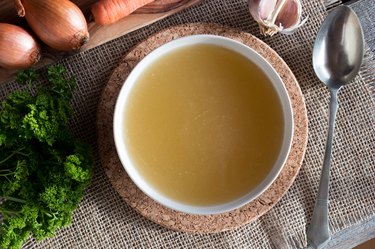
Diverticulitis occurs when one or more pouches that protrude from wall of the colon become inflamed. This condition occurs in some -- but not all -- people who have diverticulosis, which is a common and often symptom-free disorder that simply means these small pouches are present in the colon.
Diverticulitis is characterized by lower left abdominal pain, bloating, fever, and constipation or diarrhea. Treatment varies according to the severity of the condition, but diet modifications are often recommended as healing takes place. Knowing how to plan meals with diverticulitis can make the recovery period easier to manage.
Video of the Day
Video of the Day
Clear Liquid Diet
When diagnosed with diverticulitis, a clear liquid diet is often prescribed for 1 to 2 days, which allows the gut to rest and heal. Clear liquids include water, sports drinks, clear broth, tea, flavored gelatin, frozen ice pops made with clear juice, black coffee and pulp-free fruit juices, such as cranberry, grape and apple. When on a clear liquid diet, it's best to choose 1 to 2 items every few hours, as opposed to a regular schedule of meals. This diet is temporary -- after a day or two of clear liquids, the diet is usually advanced to solid foods.
Low-Fiber Diet
After a short-term diet of clear liquids, a low-fiber diet is often the next step. However, in cases of simple diverticulitis, where there is inflammation but no abscess or tears in the intestinal wall, a low-fiber diet may be recommended first -- instead of starting with clear liquids.
A low-fiber diet restricts whole grains, and instead allows white bread, white-flour tortillas, crackers, cereal, pasta or white rice. This diet also includes applesauce, canned fruit or soft, peeled fruits, well-cooked vegetables, poultry, lean meat, fish, eggs and smooth nut butters. Cheese, milk, and yogurt are also acceptable choices.
Low-Fiber Meal Ideas
Low-fiber breakfast options include white toast with creamy peanut butter and canned peaches, or cream of wheat cereal with a banana and milk. Lunch can be a turkey sandwich on white bread, applesauce and a yogurt, or chicken noodle soup with saltine crackers, cottage cheese and peeled, soft pear slices.
Dinner could be comprised of steamed white rice, grilled salmon and soft, cooked carrots or baked chicken with mashed potatoes, a slice of cornbread and diced cantaloupe. Snack choices may include yogurt, canned fruit or white crackers with smooth nut butter or tuna.
High-Fiber Diet
After the diverticulitis has resolved, a normal diet can be resumed. The long-term, optimal diet should be one that promotes long-term health. The American Gastroenterological Association (AGA) recommends a fiber-rich diet for people with diverticulosis -- even in people with a history of diverticulitis -- even though quality evidence on the role of fiber in diverticulitis prevention is lacking.
However, AGA guidelines state that there are few risks associated with a high-fiber diet, and eating a diet that emphasizes fruits, vegetables and whole grains is known to be beneficial to gut health. In addition, these guidelines do not recommend the avoidance of nuts and popcorn in people with a history of diverticulitis, since research has shown a lack of correlation between these foods and the risk of diverticulitis.
Warnings
Diverticulitis is a serious condition that requires prompt medical treatment, which may include antibiotics and sometimes surgery. Diet modifications are integral to the treatment phase of this condition, although it's important that your doctor and dietitian guide you on the optimal short and long-term diet for your condition.
Since diverticulitis can lead to serious, life-threatening complications, it's important seek medical attention right away if you have severe or persistent abdominal pain, chills, fever or blood in the stool. Also let your doctor know if you have ongoing vomiting, bloating, nausea, constipation or other change in bowel habits.
Reviewed by Kay Peck, MPH, RD
- American Gastroenterological Association: American Gastroenterological Association Institute Guideline for the Management of Acute Diverticulitis
- American Cancer Society: Low-Fiber Foods
- National Institute of Diabetes and Digestive and Kidney Disorders: Diverticular Disease
- JAMA: Nut, Corn, and Popcorn Consumption and the Incidence of Diverticular Disease
- Today's Dietitian: Diverticular Disease — A Reexamination of the Fiber Hypothesis
- Nutrients: Role of Fiber in Symptomatic Uncomplicated Diverticular Disease: A Systematic Review
Is this an emergency? If you are experiencing serious medical symptoms, please see the National Library of Medicine’s list of signs you need emergency medical attention or call 911.